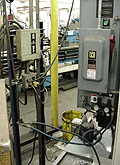Electrical Safety for Trades Employees
Evaluate the risks and hazards when planning and performing work on or near electrical systems and equipment.
Restrict access
 Restrict access to electrical systems and equipment to trained personnel.
Restrict access to electrical systems and equipment to trained personnel.
- Allow only trained professionals to perform electrical work.
- Work with high-voltage sources (greater than 600 volts) may be performed only by a qualified person with specialized training and experience.
- Keep electrical rooms properly labeled and secured.
- Obey barriers, signs, and other warnings to stay away from electrical equipment you are not authorized or trained to service.
Building occupants
Consider how electrical maintenance and service actions may impact the work and safety of building occupants.
Important: Unanticipated interruptions of electrical service may expose people to hazardous situations.
- Notify EH&S in advance, (858) 534-3660, if you are concerned your electrical work may cause a hazardous condition.
Safety guidelines
Follow these safety guidelines for work on or near electrical systems.
Important: Electricity travels in closed circuits and wants to reach the ground any way it can.
- Be aware of situations where you could become grounded while touching a "hot" wire or electrical apparatus.
- Know where your overcurrent devices are (e.g., circuit breakers and fuses) so they can be easily and quickly reached in case of emergency.

Local power disconnects
- Isolate equipment from energy sources:
- Test every circuit and every conductor every time before you touch it.
- Use a polarity tester to confirm that live ground wires have not been reversed when repair work has been done to an electrical wire.
- Follow lockout/ tagout procedures.
- Read about the UC San Diego Lockout/ Tagout Program below.
Lockout/ Tagout procedures
Treat de-energized electrical equipment and conductors as energized until lockout/ tagout, test, and ground procedures are implemented (where appropriate).
LOTO procedures ensure energy sources are disengaged or blocked, and that energy sources are de-energized and locked in the "off" position during setup, maintenance, or repair.
- See the Lockout/ Tagout Program for more information.
Work near flammables
Use special caution around flammable materials.
- Be especially cautious around flammable liquids, vapor, or dust. A spark from electrical equipment could ignite an explosion or fire.
- Ventilate the area before you start work and use only electrical equipment identified as safe for that use.
- Contact EH&S Fire & Life Safety, (858) 534-3659, if you have questions.
Reliable equipment
Use appropriate, properly functioning equipment.
- Use insulated tools and protective equipment, such as special rubber gloves or boots, when you work with electrical equipment.
- Inspect electrical equipment and wires before using them. Make sure they're properly insulated and grounded and electrical connections are tight.
- Inspect portable equipment, including extension cords, before each use. Repair or replace cords with missing insulation or separation of insulation and wires where the plug is connected.
- Don't use any piece of defective electrical equipment that sparks, smokes, smells, or shocks, or is otherwise malfunctioning. Mark it "out of order" and report it to your supervisor immediately.
- Be sure electrical plugs match their receptacles; never alter a plug (e.g., use only a three-prong outlet for a 3-prong plug).
- Never use a metal ladder around live electricity. Use ladders with nonconductive siderails if there is any possibility the ladder could contact exposed energized parts.